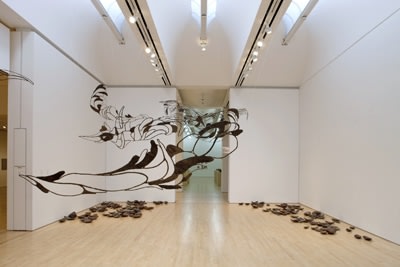
Seen from afar, down the long enfilade of galleries on the 2nd floor, Ranjani Shettar’s Sing along floats above the other more floor- and earth-bound artworks on view. The poodles of Katharina Fritsch are stolid and rooted in their rippling pool of black, while Kiki Smith‘s Lilith seems crouched on the wall in feral descent. Even Nicola Tyson‘s Red Self Portrait, arms outstretched like fins, bespeaks a downward gaze as much as upward lift. Only Sing along, seen from near or far, seems empty, light, a calligraphic curve in flight. The piece is a set of open, hovering articulations, as much absence as presence—at once abstract and evocative of natural forms. Sing along seems to redefine the gallery it inhabits and the visitors who share its space: it floats in our company and extends from the wall in ways that suggest flora, fauna, the human and seraphic… yet resists being tied down to anyone definition. Its process of making combines steel sculpture with an artisanal tradition of fabric dyeing. The work’s origin in a small village in India might seem to set it apart from modernism’s smooth, chromed forms—however, the artist has said she takes inspiration from the works of Eva Hesse and Martin Puryear. There’s a warmth and wonder I feel in the presence of this work that is rare and keeps me wanting to linger with it. It keeps me engaged and discovering. Join me as we explore the work’s antipodes and affinities this Thursday evening at 6:30.
-Peter Samis